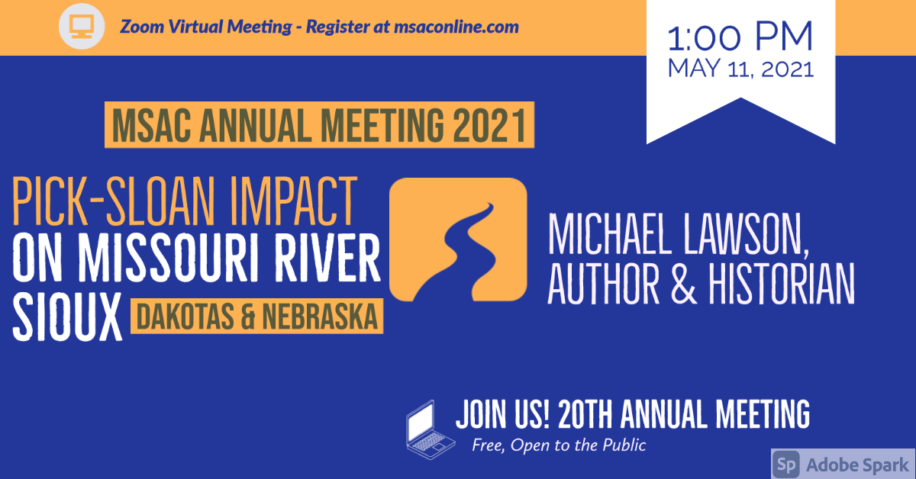Join us at 1 pm, May 11th for a free webinar. Historian Dr. Michael Lawson to provide presentation on the impact of Pick-Sloan dam projects on Sioux Reservations in the Dakotas and Nebraska.
(SPRINGFIELD, SD) – Join the Missouri Sedimentation Action Coalition for its 20th Annual Membership Meeting to be held via webinar at 1 p.m. (CST) May 11, 2021.
The meeting is free and open to the public. All interested people are encouraged to attend. The online event will be recorded and available at MSAC’s YouTube channel.
MSAC has invited Michael Lawson, an author and historian based in Annandale, Virginia, to present a glimpse at the decades of his research which provided the factual basis for Congressional legislation establishing tribal recovery trust funds totaling $385.8 million for five Sioux tribes (Cheyenne River, Crow Creek, Lower Brule, Yankton, and Santee). Dr. Lawson is the author of two books on the impact of the Missouri River Pick-Sloan dam projects on Sioux Reservations in the Dakotas and Nebraska. Dammed Indians: The Pick Sloan Plan and the Missouri River Sioux, 1944-1980, was published by the University of Oklahoma Press in 1982. Lawson updated that volume in a second work entitled Dammed Indians: The Continuing History of the Pick-Sloan Plan and the Missouri River Sioux, published by the South Dakota Historical Society Press in 2009.
In February, MSAC marked the beginning of Phase 2 to develop a sediment management plan for the Lewis and Clark Lake region. Shortly after Gavins Point Dam was completed in 1957 near Yankton, SD, people at the upper end of the lake and upstream began to feel the impacts of accumulating sediment. Currently, the lake is at least 30 percent full of sediment and by the year 2045 it is projected to be 50% full of sediment. The project to develop a sediment management plan is jointly funded by the U.S. Army Corps of Engineers and the local sponsor, MSAC. To date, 13 stakeholders along with MSAC and its members have contributed funds to the effort.
“Building a plan for the future of the Missouri River reservoirs needs not only today and tomorrow’s perspectives but also a historical one. We must remember the impacts created with the Pick-Sloan dam projects from the beginning,” said Sandy Stockholm, MSAC coordinator. “How do we collaborate and plan for the future together, everyone – local governments and Tribes – up and down the Missouri River?”
Lawson is President of MLL Consulting, LLC in Annandale. The second book, which included forewords by Senator George McGovern and the Sioux scholar Vine Deloria, Jr., was awarded the Independent Publishers 2011 Silver Medal. The South Dakota Humanities Council and the South Dakota Center for the Book also chose this volume to be its “One Book South Dakota” selection for 2012. This annual program encourages readers throughout the state to read and discuss the same book during the course of a year.
The settlements and Congressional legislation establishing the tribal recovery trust funds provided additional compensation for reservation resources and infrastructure lost to the Pick-Sloan projects. The accrued interest from these trust funds will eventually total in the billions of dollars. More recently, Lawson conducted research for the MHA Nation regarding ownership of Missouri River mineral rights within the boundaries of the Fort Berthold Reservation in North Dakota.
Before becoming a historical consultant in the private sector in 1993, Lawson served as a government historian for the National Park Service, the Smithsonian Institution, and the Bureau of Indian Affairs. During the initial part of this 13-year career with the BIA he was the staff historian for what is now the agency’s Great Plains Regional Office in Aberdeen, SD.
Additional business for MSAC’s annual meeting will be a Phase 2 update and a Board of Directors member election. MSAC’s Board of Director members with terms expiring are: Tim Cowman, representing Class I membership (government) and Jeff Peters, representing Class II membership (organizations.)
MSAC, a 510c3 nonprofit organization, was organized in 2001. It is dedicated to educating the public and to promoting the intelligent use of all available programs and funds to alleviate the sedimentation-caused problems of the Missouri River main-stem reservoirs. MSAC supports a sustainable approach to reservoir management, envisioning doing what is necessary to extend the storage capacity of the reservoir as far into the future as possible recognizing the value of our most precious resource – water.
A full agenda continues to be developed and will be available at MSAC’s Facebook page or at www.msaconline.com or www.keepitwater.com. Please note that the webinar will be free via an internet connection. A participant may choose to connect by telephone, in which case long distance charges may apply. MSAC requests that meeting attendees register via the website. Connection information will be emailed to registrants.

